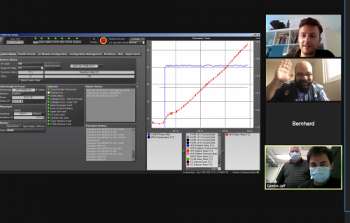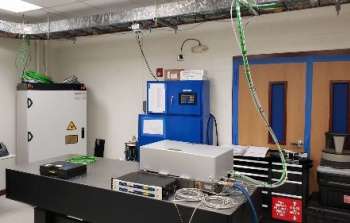sci21051 — Announcement
Gemini AO News
June 24, 2021
Gemini North Adaptive Optics (GNAO) Facility Laser Update
A new Laser Guide Star Facility (LGSF) is in development at the Gemini North telescope that will upgrade the current single laser facility to a new multi-laser and multi-guide star system. This new system will use the existing laser along with a second identical laser produced by Toptica Photonics, and generate one to four sodium beacons offering the flexibility to use multiple types of laser-assisted adaptive optics.
In September 2019 the procurement of the second GNAO laser officially began. As the world entered a global pandemic with travel severely restricted, the team at Toptica was able to build our new laser unit in a few months and were ready for Factory Acceptance Testing (FAT) in July 2020. In a first for both Gemini and Toptica, the laser FAT was conducted with GNAO team members connecting remotely to the Toptica team in Germany. After a successful FAT, the laser experienced an extended pandemic-related shipping delay and arrived in Hilo in February 2021. During the extended delay the GNAO team continued working by designing and building a new Laser Heat Exchanger to support multiple Toptica lasers as well as prepare the new GNAO Lab area at the Hilo Base Facility for acceptance of the laser.
At the start of June 2021, the Hilo On-Site Acceptance Test of the laser was performed, this time with the team from Toptica connected remotely. After a smooth three days of testing the second GNAO laser was formally accepted. It will remain in the lab for the next 18 months to test the systems being developed for the new LGSF, and will make its way to the telescope afterward.
Gemini North Ground Layer Adaptive Optics Feasibility Study
To take further advantage of the flexible new GNAO laser guide star facility, a Gemini team recently concluded a feasibility study to explore the viability of an adaptive secondary mirror (ASM) -based ground layer adaptive optics (GLAO) system for Gemini. Surpassing previous efforts that failed to find a viable solution, the team successfully identified a path to implement GLAO at Gemini. The team worked with ASM vendors to verify existing mirrors that could work on the Gemini telescopes, and identified a possible location for four pickoff and fold mirrors in the mirror cell cavity that can project the multiple laser guide star light onto wavefront sensors located inside the mirror cell. This solution allows the eventual system to pass the GLAO-corrected beam to all mounted instruments.
The team’s performance analysis confirmed that a GLAO system at Maunakea, an excellent site for significant ground layer correction, could improve seeing by a factor of two for all instruments on the telescope within a science field-of-view up to six arcmin in diameter, essentially making the current good IQ20 seeing conditions available ~80% of the time. Additionally, the team developed preliminary operational concepts including calibration and maintenance of the ASM. After holding a final review to present the feasibility study results, the team is now preparing plans for a Conceptual Design stage, and for identifying the resources needed to move forward with Conceptual Design, and complete the remaining work to design and implement the system.
About the Announcement
| Id: |
ID
sci21051
|

